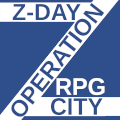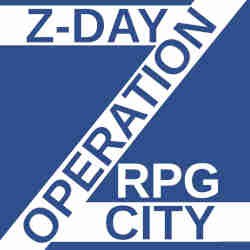Z-Day City
Originally designed in 2014 as a hybrid tabletop (TRPG) and live-action (LRPG / larp), over the years we have been developing virtual reality (VR) and augmented reality (AR) enhancements and versions of this game. The game is fun for everyone, but was originally designed to teach the use of public transit systems to Autism Spectrum populations of all ages, youth, and other special needs populations through a modern-day, near-future, esponiage-type adventure, with a twist (zombies!). Designed to initially be played as a TRPG with AR enhancements, or a full VR, and then later finish the adventure in “larp mode” actually traveling the real-world city with geo-tagged AR enhancements to complete the adventure(s). It can be played by one player or multiple players.
Find the latest information on this project at the main website: zdaycity.com
Github repo: https://github.com/RPG-Research/zday-city-rpg
Game Premise
Documentation updates pending on docs.rpg.llc
Game Implementation
Documentation updates pending on docs.rpg.llc
Opensource Public Git Repo:
Private Git Repo:
TRPG Mode
Documentation updates pending on docs.rpg.llc
LRPG Mode
Documentation updates pending on docs.rpg.llc
Larp Mode
Documentation updates pending on docs.rpg.llc
xR Mode
Documentation updates pending on docs.rpg.llc
VR Mode
Documentation updates pending on docs.rpg.llc
AR Mode
Documentation updates pending on docs.rpg.llc
Brain-Computer Interface (BCI) Integration
AI-RPG / AI-GM Integration
Documentation updates pending on docs.rpg.llc
Automated Speech Recognition (ASR) Integration
Documentation updates pending on docs.rpg.llc
Real-time Closed Captioning (CC) Integration
Documentation updates pending on docs.rpg.llc
Real-time Language Translation (Text-only) Integration
Documentation updates pending on docs.rpg.llc
Matrix Account, Communication, and Data Protocols Integration
Documentation updates pending on docs.rpg.llc
Blockchain and NFT Optional Augmentation
Documentation updates pending on docs.rpg.llc
Background
Some of this game was developed by me for a 2006 program I did for Deaf and HoH youth and adults. Over the years I expanded these games for more and more diverse populations and diverse goals.
The original version of the Z-Day City game was to teach Autism Spectrum youth and Adults how to use the public transition systems in Tacoma, Washington. This was later repeated in other cities with public transit.
Business Scope
Documentation updates pending on docs.rpg.llc
Release Road Map
Documentation updates pending on docs.rpg.llc
Technical Scope
Documentation updates pending on docs.rpg.llc
UI/UX Mockups and Wire Diagrams
Documentation updates pending on docs.rpg.llc
Use Cases
Documentation updates pending on docs.rpg.llc
Workflow Diagrams
Documentation updates pending on docs.rpg.llc
Components Diagrams
Documentation updates pending on docs.rpg.llc
UML Diagrams
Documentation updates pending on docs.rpg.llc
Infrastructure Documentation
Documentation updates pending on docs.rpg.llc
N-Tier Overview
Documentation updates pending on docs.rpg.llc
Web and Mobile (Visual) Layers
Documentation updates pending on docs.rpg.llc
Accounts and Authentication Components
Documentation updates pending on docs.rpg.llc
Gluu Implementation
Documentation updates pending on docs.rpg.llc
Matrix Implementation
Documentation updates pending on docs.rpg.llc
Middleware APIs
Documentation updates pending on docs.rpg.llc
Data Layers
Documentation updates pending on docs.rpg.llc
Databases, APIs, and Data Design Structures
Documentation updates pending on docs.rpg.llc
Screenshots and Mockups
Documentation updates pending on docs.rpg.llc
Explanation and Demonstration Videos
Documentation updates pending on docs.rpg.llc
Prospective Investor Pitch Deck
Documentation updates pending on docs.rpg.llc
Job Opportunities
Documentation updates pending on docs.rpg.llc
References
https://www2.rpgresearch.com/documents/rpg-research-project/archives/rpg-adapted-for-deaf-using-asl-flyer
https://www2.rpgresearch.com/blog/first-prototype-of-tabletop-rpg-as-a-modality-for-therapeutic-educational-intervention
https://www2.rpgresearch.com/blog/creating-larp-program-for-autism-spectrum-toddlers-1
https://www2.rpgresearch.com/blog/list-of-created-autism-spectrum-program-plans-utilizing-role-playing-games-as-intervention-modalities-from-a-therapeutic-recreation-approach
Previous version updates (2014)
https://www2.rpgresearch.com/blog/using-role-playing-games-for-autism-spectrum-participants
UPDATE: This program is based on work at Eastern Washington University with oversight by Professor Emily Messina and others. If you implement this, or similar programs, please comment and/or add your posts to the website, so that everyone can benefit from the pooled information.
I just sent to the program head, the latest draft of a recreation therapy-related activity program plan using role-playing gaming to prepare for and utilize the metropolitan Bus system for Autism spectrum participants.
From a recreation therapy perspective, this activity utilizes tabletop and live-action role-playing games to help Autism Spectrum Disorder (ASD) participants build up confidence and competence toward improved autonomy to use the public transit system.
This adventure activity begins by using tabletop RPG for phase I, and then Live-action role-playing (LARP) (actually using the buses) for the final phase II.
Having met with some of the ASD members and their families, I am hopeful that some day we will be able to schedule an actual implementation.
Below are a few edited excerpts from the 71 page document:
Appendices 11A-11D
1. Client Group: Young adults with a diagnosis on the autism spectrum who are high functioning. How to use appropriate social skills while using the public transit system
2. Client Group: Young adults with a diagnoses on the autism spectrum who are high functioning.
3. Task analysis of: Correctly uses the public transit system and demonstrates appropriate social interactions. Criterion Level: Successfully gets to the previously determined locations at the predetermined times.
4. Target behavior: Effectively using the public transit system. Plan to assess (contrived) The social skills will be assessed each time phase one is implemented (natural). The clients skills will be further assessed during the phase two implementation into the community. (assessment tool) Optionally use the Bus Skills Checklist Assessment.
5. Target behavior: Effectively using the public transit system Teaching strategies: Role-playing will be used as the main strategy in developing the skills.
Activity Overview
A social recreation activity designed for Autism Spectrum Disorder (ASD) participants using tabletop role-playing gaming (RPG) and live-action role-playing (LARP), intended to introduce, familiarize, practice, and then actually utilize the public transit system, especially buses, in their area.The activity initially uses the tabletop RPG format to help the participants gain familiarity with the public transit system in a safe and non-threatening environment. Both stages of this activity emphasize cooperative problem-solving social skills. Additionally, the participants are encouraged to use non-electronic resources to learn the transit system in the greater metropolitan area.
The original version of this project was as part of a classroom team project at Eastern Washington University for the Spring 2014 quarter for the RCLS-445-01 Processes and Techniques in Therapeutic Recreation course under Professor Emily Messina, with team members: Britany Williams, Jaki Hilzinger, and W.A. Hawkes-Robinson.
Adventure Overview and Preparation Advisory
This adventure takes place in the contemporary (as of the writing of this document) 2014 metropolitan area. However, this is a fictionalized version of reality, it is a world where super-heroes and super-villains are real, and a super-secret government espionage and law enforcement agency, in conjunction with both super heroes and regular heroes, attempt to thwart the nefarious plans of evil super-villains and their accomplices. This is modeled roughly on the Marvel Comics S.H.I.E.L.D. TV series and associated Marvel Universe setting that includes Iron Man, Captain America, The Incredible Hulk, Thor, etc. Though without ever specifically using their names or likenesses (not needed for this adventure) In the interest of avoiding copyright issues, though this adventure is modeled after the concepts, the specific names and details have been changed, and the storyline itself is completely created from scratch rather than creating any derivative works directly from the Marvel Universe.
This adventure will require some hours of preparation by the GF (Game Facilitator) to effectively run, it is not meant to be picked up by just anyone, or taken over by another GF mid-adventure, this is an entire adventure campaign, and so requires the upfront investment of time by the GF necessary for such endeavors. The Players will not need to undertake much preparation if the GF is sufficiently familiar with the campaign, setting, and rules well in advance of the first session. There should also be a fair amount of time spent by the GF getting to know what kind of adaptations may be necessary for the particular population base this adventure will be used with, in the case of this writing, involving young-adult to adult Autism Spectrum Disorder (ASD) male (and some female) participants, are specifically targeted for this assignment.
The Adventure - “Save The City From Z-Day”
The tabletop stage will initially walk everyone through meeting each other, learning the circumstances of the situation, getting a basic understanding of each Player Characters (PC) strengths/weaknesses/professions/abilities, and an orientation on how to take turns talking, taking actions, etc.
Throughout the adventure, the PCs will have each of their skills tested in specific challenges, often having to rely on multiple PC skills and specialized equipment, learning how to use the skill challenge rules and a six sided die, to cooperatively to overcome challenges, and will encourage effective communication to coordinate their efforts.
It is possible, depending on how aggressively some of the PCs act, that some combat situations (in the context of the game, not the real world) may occur, and the participants will become familiar with the basic mechanics of opposed rolls/combat rules.
These skill challenge and combat rules will not be used in the Live-Action Role-Playing (LARP) stage, they are only for the tabletop RPG stage. There will not be any combat in the LARP stage, but the players may be provided some assistance from the GF (or assistants), based on their characters abilities for skill checks, or adaptive needs if the participants have trouble solving some of the challenges on their own.
While the tabletop RPG rules are included to allow each participant to create their own characters from scratch, for the sake of getting started quickly, the GF should have a number of prepared player character sheets (see appendices) available to hand out to the players. The GF can either allow the participants to each pick their character (preferred), or if this seems it would lead to conflict, use random allocation or other means to automatically assign a character to each participant. The GF should try to have several more PC sheets available than the actual number of participants so that the participants feel they have a greater freedom of choice, for example if there are 5 participants, offer around 8 to 10 pre-generated PC sheets.
Game System Overview
For the tabletop RPG stage, this adventure uses Hawke's Simplified RPG as the de facto tabletop role-playing game system, though any system could be used. The rules for this system are made freely available under the Creative Commons license for download in PDF format from the Ea RPG website, http://www.earpg.com .
For the LARP phase of this adventure (Phase II), it is a non-combat LARP, so does not require complex rules since it is more a social interaction and clue solving / scavenger hunt activity.
Avedon (1974) Interaction pattern
Intragroup – Action of a cooperative nature by two or more persons intent upon reachingAction requires positive verbal and nonverbal interaction (Avedon, 1974, p. 169).
Phase I Goals Summary
Working cooperatively as a group, the participants will become familiar with the concept and use of a tabletop role-playing game in a socially cooperative problem solving group setting.
• Participants will become familiar with the general layout of the metropolitan area and some key locations.
• Participants will become familiar with how to find various bus routes, their times, bus stop locations, and other public transit-related information.
• Participants will become familiar with the fictional situation, how to find more information through clues and questioning non-player characters (NPCs), working cooperatively to solve challenges.
• Optional: Use of BUS Utilization Skills Assessment (BUS), pages 324-330 of Assessment Tools for Recreational Therapy and Related Fields, Third Edition.

